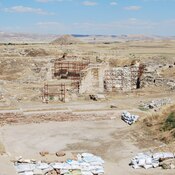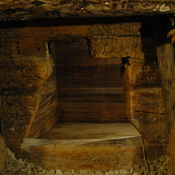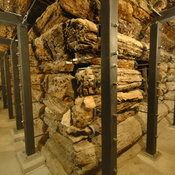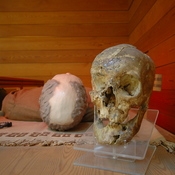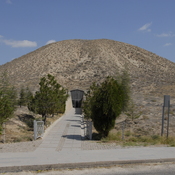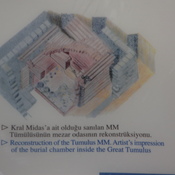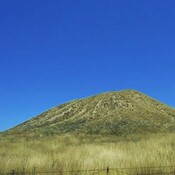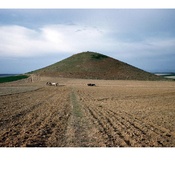Es gibt noch keine deutschsprachige Anmerkungen. Präsentiert wirden Anmerkungen auf English.
The ancient Phrygian capital of Gordium is located at the intersection of an ancient trade route at the confluence of the Porsuk and Sakkarya rivers near the Town of Polatli in a place nowadays called Yassihoyuk – Flat Mound. Rodney S. Young excavated there in 1950-1970. The settlement was inhabited from the Neolithic period ca 6300 BC until 189 BC. Excavations yielded an abundance of artifacts from Early Bronze Age III (2400-200 BC) when Anatolia used its raw produced bronze items widely distributed in the Middle East. Around 1400 BC, the town was in the territory of the Hittites After the collapse of the Hittite empire ca. 1200 B.C., control of Anatolia passed to the Phrygians, who made Gordium their capital. According to Homer's Iliad, the Phrygians participated, as close allies of the Trojans in the Trojan War1. The Phrygian empire covers the Urartu kingdom in Armenia and Taurus Mountain to the Lydian border on the West. The names Mushki and Tabal appearing in the Assyrian annals ca 1160 BC are thought to refer to Phrygians and their lands. As the capital of the Phrygian kingdom, Gordion flourished during the Middle Phrygian period, which began ca.800 BC. Gordion is connected with the legendary King Midas and Gordion Knot. In 836 BC the Phrygian land of Tabal was forced to submit by Assyrians. Eventually after battles between Assyrians and an alliance against Assyria, Tabal was defeated and became Assyrian Province in 712 BC. Mita is recorded in Greek as Midas (ca 725-696 BC) settled down in Gordion. In 696 BC Phrygian capital was destroyed by Cimmerians and King Midas the last Phrygian king was as it is said forced by invaders to commit suicide by drinking bull's blood. Lydians who gained control over Anatolia occupied Gordium in 650 BC. In the sixth century Assyrians took over Anatolia. Phrygian independence ended with subjection to Persian rule by Cyrus the Great (ca 600-530 BC) around 540 BC. Then Phrygia became a satrapy with Daskyleion as its capital. In 278 BC Galatians attacked Gordium and dispersed inhabitants. Eventually after the Romans attacked and drove out inhabitants Gordium was deserted.
Sources:
- http://www.sas.upenn.edu/~nmiller0/Tour_SouthRidge.Turkish.html - in Turkish but worth looking at for the photos of surroundings and clear maps.
- http://sites.museum.upenn.edu/gordion/resources/bibliography/
- Charles Brian Rose, Fieldwork at Phrygian Gordion, 2013–2015, American Journal of Archaeology Vol. 121, No. 1 (January 2017), pp. 135-178 - http://www.ajaonline.org/sites/default/files/1211_Rose.pdf
- Oscar White Muscarella, Review Article. Deconstructing the Destruction of King Midas' Gordion, Brill 2012, Ancient Civilizations from Scythia to Siberia 18, pp. 377-390
- Keith DeVries, Bernd Kromer, Peter Ian Kuniholm, Richard F. Liebhart, Sturt W. Manning, Maryanne W. Newton, G. Kenneth Sams, and Mary M. Voigt. The New Chronology of Iron Age Gordion. Edited by Rose C. Brian and Darbyshire Gareth. University of Pennsylvania Press, 2011
- Carolyn Aslan, Review of The New Chronology of Iron Age Gordion, in: Classical Review 63 (2) 2013, pp. 564-566
- Homerus, Ilias Book III
- Brendan Burke eds.: The Rebuilt Citadel at Gordion: Building A and the Mosaic Building Complex, in: The Archaeology of Phrygian Gordion, Royal City of
- https://www.academia.edu/1580253/Alalakh_A%C3%A7%C3%A7ana_H%C3%B6y%C3%BCk_2007_Y%C4%B1l%C4%B1_%C3%87al%C4%B1%C5%9Fmalar%C4%B1_XXX_KST, p. 148.
- Midas: Gordion Special Studies 7, University of Pennsylvania Press 2013
- Young, Rodney S. “Gordion: Preliminary Report, 1953.” American Journal of Archaeology, vol. 59, no. 1, Archaeological Institute of America, 1955, pp. 1–18, https://doi.org/10.2307/500929.
Referenzen
- ↑Ere now have I journeyed to the land of Phrygia, rich in vines, and there I saw in multitudes the Phrygian warriors, masters of glancing steeds, even the people of Otreus and godlike Mygdon, that were then encamped along the banks of Sangarius
The ancient Phrygian capital of Gordium is located at the intersection of an ancient trade route at the confluence of the Porsuk and Sakkarya rivers near the Town of Polatli in a place nowadays called Yassihoyuk – Flat Mound. Rodney S. Young excavated there in 1950-1970. The settlement was inhabited from the Neolithic period ca 6300 BC until 189 BC. Excavations yielded an abundance of artifacts from Early Bronze Age III (2400-200 BC) when Anatolia used its raw produced bronze items widely distributed in the Middle East. Around 1400 BC, the town was in the territory of the Hittites After the collapse of the Hittite empire ca. 1200 B.C., control of Anatolia passed to the Phrygians, who made Gordium their capital. According to Homer's Iliad, the Phrygians participated, as close allies of the Trojans in the Trojan War1. The Phrygian empire covers the Urartu kingdom in Armenia and Taurus Mountain to the Lydian border on the West. The names Mushki and Tabal appearing in the Assyrian annals ca 1160 BC are thought to refer to Phrygians and their lands. As the capital of the Phrygian kingdom, Gordion flourished during the Middle Phrygian period, which began ca.800 BC. Gordion is connected with the legendary King Midas and Gordion Knot. In 836 BC the Phrygian land of Tabal was forced to submit by Assyrians. Eventually after battles between Assyrians and an alliance against Assyria, Tabal was defeated and became Assyrian Province in 712 BC. Mita is recorded in Greek as Midas (ca 725-696 BC) settled down in Gordion. In 696 BC Phrygian capital was destroyed by Cimmerians and King Midas the last Phrygian king was as it is said forced by invaders to commit suicide by drinking bull's blood. Lydians who gained control over Anatolia occupied Gordium in 650 BC. In the sixth century Assyrians took over Anatolia. Phrygian independence ended with subjection to Persian rule by Cyrus the Great (ca 600-530 BC) around 540 BC. Then Phrygia became a satrapy with Daskyleion as its capital. In 278 BC Galatians attacked Gordium and dispersed inhabitants. Eventually after the Romans attacked and drove out inhabitants Gordium was deserted.
Sources:
- http://www.sas.upenn.edu/~nmiller0/Tour_SouthRidge.Turkish.html - in Turkish but worth looking at for the photos of surroundings and clear maps.
- http://sites.museum.upenn.edu/gordion/resources/bibliography/
- Charles Brian Rose, Fieldwork at Phrygian Gordion, 2013–2015, American Journal of Archaeology Vol. 121, No. 1 (January 2017), pp. 135-178 - http://www.ajaonline.org/sites/default/files/1211_Rose.pdf
- Oscar White Muscarella, Review Article. Deconstructing the Destruction of King Midas' Gordion, Brill 2012, Ancient Civilizations from Scythia to Siberia 18, pp. 377-390
- Keith DeVries, Bernd Kromer, Peter Ian Kuniholm, Richard F. Liebhart, Sturt W. Manning, Maryanne W. Newton, G. Kenneth Sams, and Mary M. Voigt. The New Chronology of Iron Age Gordion. Edited by Rose C. Brian and Darbyshire Gareth. University of Pennsylvania Press, 2011
- Carolyn Aslan, Review of The New Chronology of Iron Age Gordion, in: Classical Review 63 (2) 2013, pp. 564-566
- Homerus, Ilias Book III
- Brendan Burke eds.: The Rebuilt Citadel at Gordion: Building A and the Mosaic Building Complex, in: The Archaeology of Phrygian Gordion, Royal City of
- https://www.academia.edu/1580253/Alalakh_A%C3%A7%C3%A7ana_H%C3%B6y%C3%BCk_2007_Y%C4%B1l%C4%B1_%C3%87al%C4%B1%C5%9Fmalar%C4%B1_XXX_KST, p. 148.
- Midas: Gordion Special Studies 7, University of Pennsylvania Press 2013
- Young, Rodney S. “Gordion: Preliminary Report, 1953.” American Journal of Archaeology, vol. 59, no. 1, Archaeological Institute of America, 1955, pp. 1–18, https://doi.org/10.2307/500929.
Referenzen
- ↑Ere now have I journeyed to the land of Phrygia, rich in vines, and there I saw in multitudes the Phrygian warriors, masters of glancing steeds, even the people of Otreus and godlike Mygdon, that were then encamped along the banks of Sangarius







